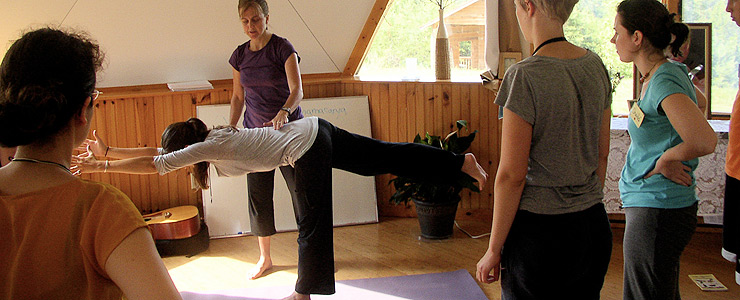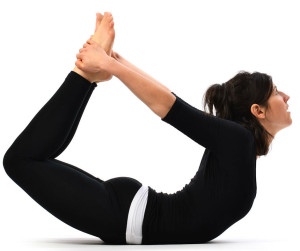
While I teach meditation to help people find mental peace and spiritual fulfilment, meditators shouldn’t forget about physical health.
In the last blog I talked of how food is essential for spiritual progress. Certain foods, I noted, encourage mental harmony, as well as giving us physical health.
Here I’ll talk of how the right exercise can help our “innercise.”
Exercise is working with our body to achieve a good level of health. Our “innercise” is our mental activity which leads us toward mental balance and harmony and ultimately to spiritual fulfilment.

By Kakiletimadhu – Own work, CC BY-SA 4.0, https://commons.wikimedia.org/w/index.php?curid=50200301
In this blog I want to consider the role of asanas – yogic exercises – in our yogic and spiritual life.
In later blogs we can discuss some more advanced yogic exercises.
Asanas are most useful when prescribed personally by a qualified, experienced teacher, and when they are practiced regularly by the student.
‘Asana’ means a position which is easily held. It may refer to a comfortable place to sit for meditation, but more commonly we see asanas as physical exercises, designed to build a stronger nervous system. They also help to balance the secretions of our endocrine glands (which include the pancreas, gonads, thyroid, parathyroid, adrenal, pituitary and pineal glands). When these glands are functioning well, they help our emotions and mind to be more balanced. They also improve the function of the various organs.
In the Ananda Marga system of yoga, asanas can be used to resolve physical problems. Poor digestion? A bad back? Poor blood circulation? Are you overweight or underweight? These and numerous other problems can be helped with yoga asanas.
Yoga asanas also help us find a balanced mind working in harmony with the body to help our meditation. Thus someone who needs to study more may be advised to use a certain asana. Someone who finds it difficult to sit for meditation may be advised to use another asana. Asanas may help someone to overcome excessive shyness or to develop more courage or a better memory.
Asanas are most useful when prescribed personally by a qualified, experienced teacher, and when they are practiced regularly by the student.
Generally the Ananda Marga society teaches meditation first, and then we prescribe asanas for each individual. While general yoga or asana classes can be beneficial, I find that the most benefit comes when one has a personal set of asanas to do daily. The asanas are designed to support your meditation and to help you with your personal physical or mental problems.
While medical care is important, the body has a great ability to heal itself if given time, rest and good nutrition. Asanas assist this process. “Yoga,” Swami Vishnudevananda says, “aims to remove the root cause of all diseases, not to treat its symptoms.”
By Sonic Fitness Sports Photography (Joe and Michael) https://www.flickr.com/photos/sonicfitness/
But how do we know this?
In recent decades yoga asanas have undergone a lot of academic research. www.elsevier.comnotes some of these studies, in, for example, Complementary Therapies in Clinical Practice, or at the University of Miami, the University of California, Irvine and, surprisingly to me, at Islamic University Azad, in Iran. Harvard University and the National Institutes of Health in the USA, and many other studies, also comment positively on the effects of yoga asanas.
The asanas are designed to support your meditation and to help you with your personal physical or mental problems.
These studies confirm what yogis have known for thousands of years. In ancient times yogis had their laboratories, of sorts. Their research was based on observation, trial and error and sharing results with other yogis, and doing this over many generations.
In the old days, many yogis lived in nature, in the forests and jungles. They invented some asanas by observing the animals around them. Noting a certain animal had a specific trait, they practiced the animal’s posture to see if they might acquire something of the animal’s nature.
For example, a peacock has very strong digestion. So the yogis developed a position, which is similar to a peacock’s posture. This position puts acute pressure on the stomach and helps people improve their digestion.

Gradually the yogis realized asanas can influence our mind and emotions. An asana called ‘viirasana’ (brave posture) helps people acquire more courage. Another posture, ‘kurmakasana’ (tortoise posture), helps one become more introverted. Through many generations of experiment and practice, yogis developed a body of knowledge related to the effects of asanas.
It is said that there are perhaps 50,000 asanas. However, in Ananda Marga we use about 50 asanas plus some related postures, which are most useful. A judicious combination of these asanas can help one to keep good health. Usually a student will practice three to five asanas in the morning and a similar number at night to get the most benefit from the asanas.
As with meditation or anything else you want to learn, practice makes perfect in the field of asanas. The accompanying images show a few of the main asanas.
For more information about the benefits of asanas, and about meditation in general, you can read my book: “Meditation: Searching for the Real You”, available online.